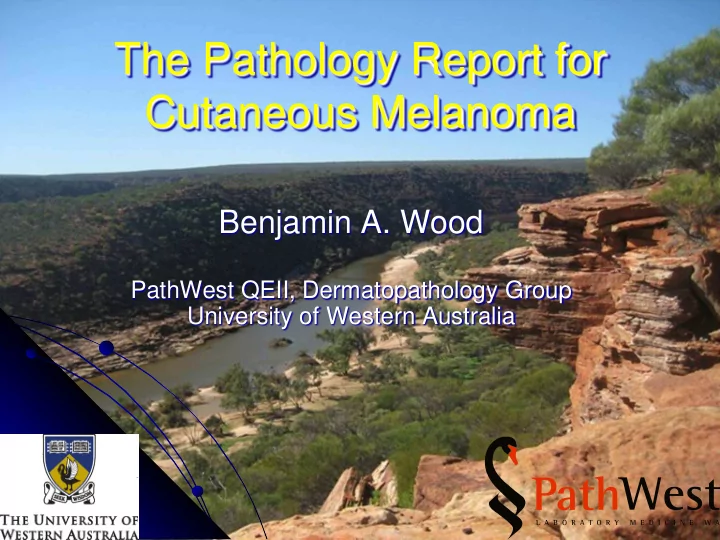

The Pathology Report for Cutaneous Melanoma Benjamin A. Wood PathWest QEII, Dermatopathology Group University of Western Australia
Getting to the Starting Line Diagnosis: Microstaging Applies to Invasive Melanoma Primary cutaneous melanoma Be aware of nodular melanoma issues Problematic cases Atypical Spitz Tumours/Spitzoid melanoma Atypical blue naevus/blue naevus like melanoma Some cases of melanoma arising in congenital naevi Putative primary dermal melanoma Pigmented epithelioid melanocytoma
The Melanoma Synoptic Report Advantages of combined synoptic reporting: International standardisation (ICCR) Completeness of data Uniformity of format Ease of interpretation Potential for data linkage
Melanoma Subtype The following are the most common WHO subtypes: Superficial spreading melanoma Nodular melanoma Lentigo maligna melanoma Subtype is not of independent prognostic significance for the common types There is emerging evidence that these subtypes show some correlation with pathogenic classes and molecular subtypes
Breslow Thickness
Breslow Thickness is Used to Determine T stage T1: <1mm thick T2: 1.01-2mm thick T3: 2.01-4mm thick T4: >4mm thick
Clark Level
Clark Level Prognostic value independent of thickness, ulceration and mitotic activity is limited Clark level is no longer used to subdivide T1 lesions It remains true that patients with thin Clark level 2 tumours (without regression) are at very low risk of developing metastasis
Ulceration
Ulceration Ulceration is an important negative prognostic factor Stratifies “a” and “b” substage in all T categories Ulceration is definitionally non-traumatic Clinical history can be vital in this regard
Mitotic Rate 1 mm 2
Mitotic Rate “Hot Spot”
Mitotic Rate (Equal) second most powerful prognostic factor Used to stratify T1a and T1b
Tumour Stage
Satellite Metastasis
Satellite Metastasis Satellite lesions grossly visible cutaneous or subcutaneous metastases occurring within 2 cm of the primary tumour. Microsatellites any discontinuous nest of intralymphatic metastatic cells greater than 0.05 mm in diameter that are clearly separated by normal dermis (not fibrosis or inflammation) from the main invasive component of melanoma by a distance of at least 0.3 mm. ‘In transit metastases’ cutaneous and/or subcutaneous metastases occurring within lymphatics lying at a distance greater than 2 cm from the primary melanoma in the region between the primary and the first echelon of regional lymph nodes. All probably represent the same process, and the present data show no difference in outcome between them. The presence of these features without lymph node metastases defines the pN2c category.
Other Data Points Tumour infiltration by lymphocytes Regression Lymphatic/vascular space invasion Perineural invasion
Margins Involvement of the surgical margin may result in regrowth or metastases from residual melanoma. The report should document the distance of melanoma from: peripheral margin, in situ component peripheral margin, invasive component deep margin, invasive component Do not conflate clinical margin recommendations and histological measurements!
Microscopic Description/Other Comments Brief description of the tumour If necessary, rationale for diagnosis, discussion of difficult issues
For more details, references, questions: benjamin.wood@health.wa.gov.au Phone: 9346 1862 or 0438 694 627 Marcoola B Beach, S Sunsh shine Coast st, Qld
Recommend
More recommend